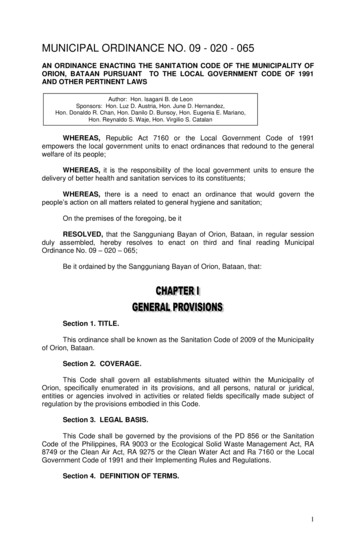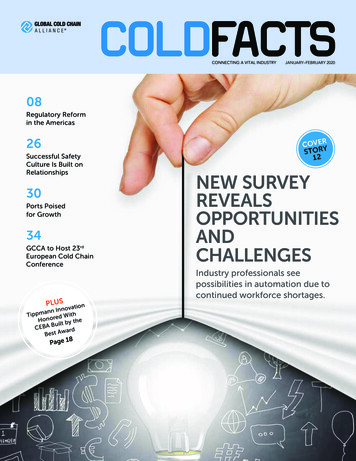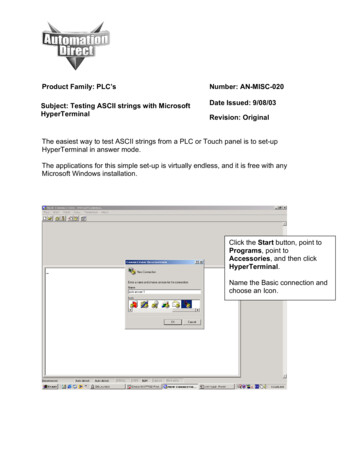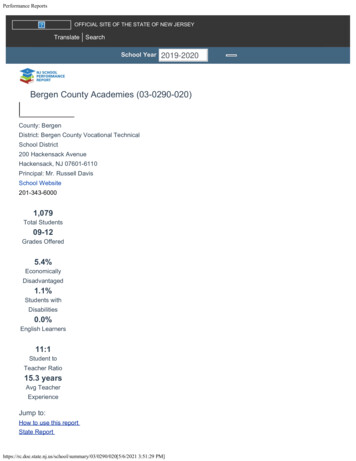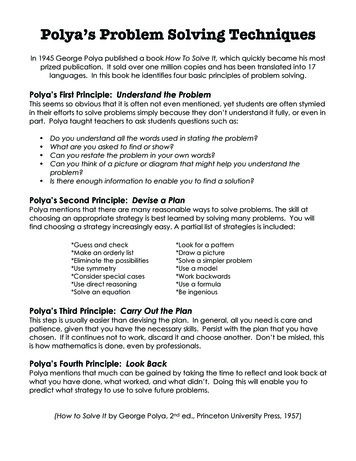
Transcription
FRM PART I1 BOOK 1: MARKET RISK MEASUREMENT AND MANAGEMENT02012 Kaplan, Inc., d.b.a. Kaplan Schweser. All rights reserved.Printed in the United States of America.ISBN: 978- 1-4277-388 1-3 / 1-4277-388 1-5PPN: 3200-2 111Required Disclaimer: GARJ?@does not endorse, promote, review, or warrant the accuracy of the products orservices offered by Kaplan Schweser of FRM@related information, nor does it endorse any pass rates claimedby the provider. Further, GAW@ is not responsible for any fees or costs paid by the user to Kaplan Schweser,nor is GARJ?@responsible for any fees or costs of any person or entity providing any services to KaplanSchweser. FRM@,CARP@,and Global Association of Risk r o f e s s i o n a l ares trademarks owned by theGlobal Association of Risk Professionals, Inc.GARP FRM Practice Exam Questions are reprinted with permission. Copyright 201 1, Global Association ofRisk Professionals. All rights reserved.These materials may not be copied without written permission from the author. The unauthorized duplicationof these notes is a violation of global copyright laws. Your assistance in pursuing potential violators of this law isgreatly appreciated.Disclaimer: The Schweser Notes should be used in conjunction with the original readings as set forth byGAW@. The information contained in these Study Notes is based on the original readings and is believed to beaccurate. However, their accuracy cannot be guaranteed nor is any warranty conveyed as to your ultimate examsuccess.Page 20 2 0 12 Kaplan, Inc.
NTRODUCTION TO THE 20 12PLAN SCHWESERSTUDYNOTESThank you for trusting Kaplan Schweser to help you reach your career and academicgoals. We are very pleased to be able to help you prepare for the 20 12 FRM Exam. In thisintroduction, I want to explain what is included in the Study Notes, suggest how you canbest use Kaplan Schweser materials to prepare for the exam, and direct you toward othereducational resources you will find helpful as you study for the exam.Study Notes-A 4-book set that includes complete coverage of all risk-related topic areasand AIM statements, as well as Concept Checkers (multiple-choice questions for everyassigned reading) and Challenge Problems (exam-like questions). At the end of each book,we have included relevant questions from past GARP FRM practice exams. These oldexam questions are a great tool for understanding the format and difficulty of actual examquestions.To help you master the FRM material and be well prepared for the exam, we offer severaladditional educational resources, including:8-Week Online Class-Live online program (eight 3-hour sessions) that is offered eachweek, beginning in March for the May exam and September for the November exam. Theonline class brings the personal attention of a classroom into your home or office with 24hours of real-time instruction led by either Dr. John Paul Broussard, CFA, FRM, PRMo r Dr. Greg Filbeck, CFA, FRM, CAIA. The class offers in-depth coverage of difficultconcepts, instant feedback during lecture and Q&A sessions, and discussion of past FRMexam questions. Archived classes are available for viewing at any time throughout the studyseason. Candidates enrolled in the Online Class also have access to downloadable slide filesand Instructor E-mail Access, where they can send questions to the instructor at any time.If you have purchased the Schweser Study Notes as part of the Essential, Premium, orPremiumPlus Solution, you will also receive access to Instructor-led Office Hours. OfficeHours allow you to get your FRM-related questions answered in real time and viewquestions from other candidates (and faculty answers) as well. Office Hours is a text-based,live, interactive, online chat with the weekly online class instructor. Archives of previousInstructor-led Office Hours sessions are sorted by topic and are posted shortly after eachsession.Practice hams-The Practice Exam Book contains two full-length, 80-question (4-hour)exams. These exams are important tools for gaining the speed and confidence you willneed to pass the exam. Each exam contains answer explanations for self-grading. Also, byentering your answers at Schweser.com, you can use our Performance Tracker to find outhow you have performed compared to other Kaplan Schweser FRM candidates.02012 Kaplan, Inc.Page 3
Interactive Study Calendar-Use your Online Access to tell us when you will start andwhat days of the week you can study. The Interactive Study Calendar will create a studyplan just for you, breaking each topic area into daily and weekly tasks to keep you on trackand help you monitor your progress through the FRM curriculum.Online Question Database-In order to retain what you learn, it is important that youquiz yourself often. We offer download and online versions of our FRM SchweserProQbank, which contains hundreds of practice questions and explanations for Part I1 of theFRM Program.In addition to these study products, there are many educational resources available atSchweser.com, including the FRM Video Library and the FExam-tips Blog. Just loginto your account using the individual username and password that you received when youpurchased the Schweser Study Notes.How to SucceedThe FRM exam is a formidable challenge, and you must devote considerable time andeffort to be properly prepared. You must learn the material, know the terminology andtechniques, understand the concepts, and be able to answer at least 70% of the questionsquickly and correctly. 250 hours is a good estimate of the study time required on average,but some candidates will need more or less time depending on their individual backgroundsand experience. To provide you with an overview of the FRM Part I1 curriculum, we haveincluded a list of all GARP assigned readings in the order they appear in our Study Notes.Every topic in our Notes is cross-referenced to an FRM assigned reading, so should yourequire additional clarification with certain concepts, you can consult the appropriateassigned reading.There are no shortcuts to studying for this exam. Expect GARP to test you in a way thatwill reveal how well you know the FRM curriculum. You should begin studying earlyand stick to your study plan. You should first read the Study Notes and complete theConcept Checkers for each topic. At the end of each book, you should answer the providedChallenge Problems and practice exam questions to understand how concepts have beentested in the past. You can also attend our 8-Week Online Class to assist with retention ofthe exam concepts. You should finish the overall curriculum at least two weeks before theFRM exam. This will allow sufficient time for Practice Exams and further review of thosetopics that you have not yet mastered.Best wishes for your studies and your continued success,Eric Smith, CFA, FRMSenior Project ManagerKaplan SchweserPage 402012 Kaplan, Inc.
r R r s MEASUREMENT AND MANAGEMENTPart I1 Exam Weight: 25%Kevin Dowd, Measuring Market Risk, 2nd Edition (West Sussex, England: John Wiley &Sons, 2005).1:2:3:4:Chapter 3 - Estimating Market Risk MeasuresChapter 4 - Non-parametric ApproachesChapter 5 - Modeling Dependence: Correlations and Copulas - AppendixChapter 7 - Parametric Approaches (11): Extreme ValuePhilippe Jorion, Ilabe-at-Risk: The New Benchmark for Managing Financial Risk, 3rd Edition(New York: McGraw-Hill, 2007).5: Chapter 6 - Backtesting VaR6:Chapter 11 - VaR MappingBruce Tuckrnan, Fixed Income Securities, 2nd Edition (Hoboken: John Wiley & Sons, 2002).7: Chapter 6 - Measures of Price Sensitivity Based on Parallel Yield Shifts8: Chapter 7 - Key Rate and Bucket Exposures9:Chapter 9 - The Science of Term Structure ModelsJohn Hull, Options, Futum, and Other Derivatives, 8th Edition (New York: Pearson PrenticeHall, 2012).10: Chapter 19 - Volatility Smiles11: Chapter 25 - Exotic OptionsFrank Fabozzi, Anand Bhattacharya, William Berliner, Mortgage Backed Securities,2nd Edition (Hoboken, NJ: John Wiley & Sons, 2006).12: Chapter 1 - Overview of Mortgages and the Consumer Mortgage MarketPietro Veronesi, Fixed Income Secun'ties (Hoboken, NJ: John Wiley & Sons, 20 10).13: Chapter 8 - Basics of Residential Mortgage Backed SecuritiesFrank Fabozzi, Anand Bhattacharya, William Berliner, Mortgage Backed Securities,2nd Edition14: Chapter 2 - Overview of the Mortgage-Backed Securities Market15: Chapter 10 - Techniques for Valuing MBS0 2 0 12 Kaplan, Inc.Page 5
CREDITRISKMEASUREMENTAND MANAGEMENTPart I1 Exam Weight: 25%John Hull, Options, Futures, and Other Derivatives, 8th Edition.16: Chapter 23 - Credit a s kLinda Allen, Jacob Boudoukh, Anthony Saunders, UnderstandingMarket, Credit andOperationalRisk: The Ihlue at Risk Approach (Oxford: Blackwell Publishing, 2004).17: Chapter 4 - Extending the VaR Approach to Non-tradable LoansArnaud de Servigny and Olivier Renault, Measuring and Managing Credit Risk (New York:McGraw-Hill, 2004).18: Chapter 3 - Default Risk: Quantitative Methodologies19: Chapter 4 - Loss Given DefaultMichael Ong, internal Credit Risk Models: CapitalAllocation and Performance Measurement(London: Risk Books, 1999).20: Chapter 6 - Portfolio Effects: Risk Contributions and Unexpected LossesLeo Tillman (ed.), ALM of Financial institutions (London: Euromoney InstitutionalInvestor, 2003).2 1: "Measuring and Marking Counterparty a s k " by Eduardo Canabarro and Darrell DuffieEduardo Canabarro (editor), Counterparty Credit Risk (London: Risk Books, 2009).22: Chapter 6 - Pricing and Hedging Counterparty Risk: Lessons Re-Learned?, by EduardoCanabarroRenk M. Stulz, Risk Management Q Derivatives (Florence, KY: Thomson South-Western,2002).23: Chapter 18 - Credit Risks and Credit DerivativesChristopher Culp, Structured Finance and insurance: The Art of Managing Capital and Risk(Hoboken, NJ: John Wiley & Sons, 2006).24: Chapter 12 - Credit Derivatives and Credit-Linked Notes25: Chapter 13 - The Structuring Process26: Chapter 17 - Cash Collateralized Debt ObligationsPage 602012 Kaplan, Inc.
40: Eric Cope, Giulio Mignola, Gianluca Antonini, and Roberto Ugoccioni, "Challengesand pitfalls in measuring operational risk from loss data," Thejournal of OperationalRisk, Volume 4lNumber 4, Winter 20091 10: pp. 3-27.41. De Fontnouvelle, Patrick, Eric S. Rosengren, and John S. Jordan, 2006. "Implicationsof Alternative Operational Risk Modeling Techniques," Ch. 10 in Mark Carey and RenCStulz (eds.), Risks of Financial Institutions, NBER, 475-505.42: Darrell Duffie, 201 0. "Failure Mechanics of Dealer Banks," journal ofEconomicPerspectives, 24: 1, 5 1-72.43: "Base1 11: International Convergence of Capital Measurement and Capital Standards:A Revised Framework-Comprehensive Version," (Base1 Committee on BanlungSupervision Publication, June 2006).44: "Base1 111: A Global Regulatory Framework for More Resilient Banks and BankingSystems-Revised Version," (Base1 Committee on Banlung Supervision Publication,June 201 1).45: "Base1 111: International Framework for Liquidity Risk Measurement, Standards andMonitoring," (Base1 Committee on Banking Supervision Publication, December 20 10).46: "Revisions to the Base1 I1 Market Risk Framework-Updated as of 3 1 December 201 0,"(Base1 Committee on Banlung Supervision Publication, February 20 11).47: "Developments in Modelling Rtsk Aggregation," (Base1 Committee on BankingSupervision Publication, October 20 10).Rrs MANAGEMENTAND ISTMENTMANAGEMENTPart I1 Exam Weight: 15%Rtchard Grinold and Ronald Kahn, Active Portfolio Management: A Quantitative Approachfor Producing Superior Returns and Controlling Risk, 2ndEdition, (New York: McGraw-Hill,2000).48: Chapter 14 - Portfolio ConstructionZvi Bodie, Alex Kane, and Alan J. Marcus, Investments, 9th Edition (New York: McGrawHill, 20 10).49: Chapter 24 - Portfolio Performance Evaluation50: Eugene Fama and Kenneth French, 2004. "The Capital Asset Pricing Model: Theoryand Evidence," journal of Economic Perspectives 18:3, 25-46.Page 802012 Kaplan, Inc.
Robert Litterman and the Quantitative Resources Group, Modern Investment Management:An Equilibrium Approach (Hoboken, NJ: John Wiley & Sons: 2003).5 1: Chapter 17 - Risk Monitoring and Performance MeasurementPhilippe Jorion, blue-at-Risk: The New Benchmark fir Managing Financial Risk, 3rdEdition.52: Chapter 7 - Portfolio Risk: Analytical Methods53: Chapter 17 - VaR and Risk Budgeting in Investment ManagementLeslie Rahl (ed.), Risk Budgeting A New Approach to Investing (London: Risk Books, 2004).54: Chapter 6 - Risk Budgeting for Pension Funds and Investment Managers Using VaR, byMichelle McCarthyDavid I? Stowell, An introduction to Inveshent Banks, Hedge Funds, and Private Equity(Academic Press, 20 10).55: Chapter 11 - Overview of Hedge Funds56: Chapter 12 - Hedge Fund Investment Strategies57: Chapter 16 - Overview of Private Equity58: Stephen Brown, William Goetzmann, Bing Liang, Christopher Schwarz, "Trust andDelegation," May 28, 2010.59: Andrew W. Lo, "Risk Management for Hedge Funds: Introduction and Overview,"FinancialAnalyrtsjoumal, Vol. 57., No. 6 (Nov.-Dec., 2001), pp. 16-33.GO: Arnir E. Khandani and Andrew W. Lo, "An Empirical Analysis of Hedge Funds, MutualFunds, and U.S. Equity Portfolios," June 24, 2009.61: Greg N. Gregoriou and Franciois-Serge Lhatant, ''Madoff: A Riot of Red Flags,"December, 2008.CURRENTISSUES INPart II Exam Weight: 10%FINANCLALMAR62: Gregory Connor, Thomas Flavin, and Brian O'Kelly, "The U.S. and Irish Credit Crises:Their Distinctive Differences and Common Features."63: Report to the Boards of Directors of Allied Irish Banks, I?L.C., Allfirst Financial Inc.,and Allfirst Bank Concerning Currency Trading Losses Submitted by PromontoryFinancial Group and Wachtell, Lipton, Rosen & Katz (March 12, 2002).64: Gary Gorton, "Slapped in the Face by the Invisible Hand: Banking and the Panic of2007," (May 9, 2009).02012 Kaplan, Inc.Page 9
IMF, "Global Financial Stability Report (Summary Version)," (September 20 11).65: Chapter 3 - Toward Operationalizing Macroprudential Po
Challenge Problems and practice exam questions to understand how concepts have been tested in the past. You can also attend our 8-Week Online Class to assist with retention of the exam concepts. You should finish the overall curriculum at least two weeks before the FRM exam. This will allow sufficient time for Practice Exams and further review of those

